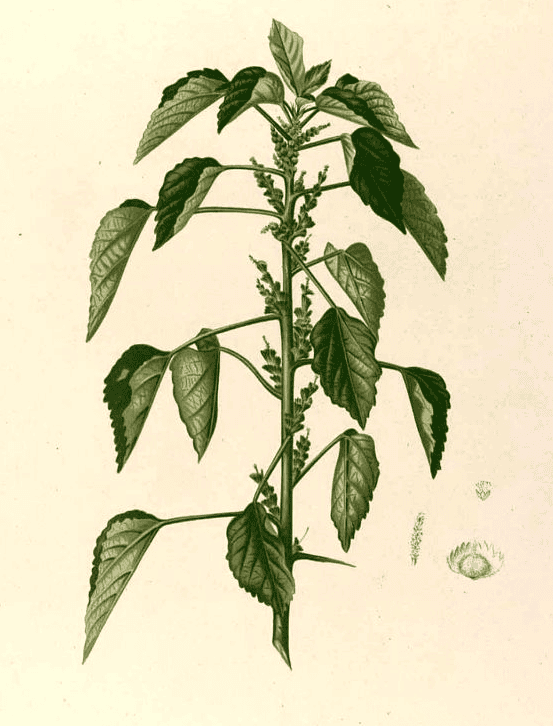Acalypha, Haritamanjari
Indian AcalyphaHaritamanjari, Akakiya, Kuppi (Ayurveda)
Kuppaimani (Siddha)
Kuppi (Unani)
Tie Xian (TCM)
 M. Blanco, Flora de Filipinas. (1875)
M. Blanco, Flora de Filipinas. (1875)Botanical name:
Acalypha Indica, A. ciliata (Lesser variety)
Parts used:
Leaf, root; Whole Plant
Temperature & Taste:
Warm, dry. Pungent, Bitter. Slightly Toxic.
Uses:
1. Clears Phlegm, Stops Cough and Wheezing: (Ayurveda, Siddha, Unani)
-violent and spasmodic Cough, Asthma (decoction of leaf or root)
-Bronchitis, especially in children; Pneumonia
-Consumption, Hemoptysis
-for these uses, the juice is given (in low dose)
2. Clears Damp, Moves Qi:
-Promotes digestion and appetite
-Colic, flatulence, diarrhea
3. Clears Wind-Damp, Eases Pain:
-Arthritic diseases, Rheumatoid Arthritis
-Headache; also for acute Mania
4. Promotes Stool, Kills Worms: (Ayurveda, Siddha, Unani)
-Worms, especially in children
-gentle laxative, especially in children (juice orally or suppository)
-leaf decoction is laxative, root decoction is cathartic
5. Emetic::
-used to promote Vomiting, and clear Phlegm
6. Externally:
-leaf paste is applied to Skin diseases including Scabies, mixed with salt or Turmeric
-juice mixed with oil is applied to Rheumatoid arthritis
-powdered leaves are applied to bed sores
-paste of the leaves is applied to burns
-leaf paste is applied to Toothache, or the decoction is gargled
-decoction is applied to earache
-leaf paste is applied to wounds (Ayurveda, Siddha, Unani)
-cataplasm of the fresh leaf is applied to painful bites and stings, including Snake Bite (Ayurveda, Siddha, Unani)
-applied to Syphilitic Ulcers
Dose:
Small doses are expectorant, larger doses are emetic.
Powder of the whole plant: 3–5 grams (API)
Juice: 5–10mls, diluted (API); half–1 teaspoonful; to promote vomiting in children, dose was given as 1 teaspoonful of the juice.
Infusion of the Root (1 in 10): half–1 fluid ounce
Decoction of the leaf (1 in 20): half–1 fluid ounce
Tincture (1 in 8): half–1 fluid dram
Liquid Extract (1:1): 10–60 drops
Comment:
Regarded as a safe, effective emetic in place of Senega or Ipecac
Substitute:
Senega can generally replace Acalypha.
Main Combinations:
1. Bronchitis in Children, juice with Honey
2. Worms in children, Acalypha with Garlic
3. Topical for Wounds and Scabies, leaf paste is mixed with Turmeric
4. Juice mixed with Lime is applied to skin diseases
Major Formulas:
Cautions:
1. Fresh herb is toxic and emetic.
2. Causes intestinal irritation
3. The Pollen has been known to cause allergy
Toxicity:
–Clinical Characteristics of Acalypha indica Poisoning
–Acalypha indica induced hemolytic crisis
Main Preparations used:
GENERAL / REVIEW:
–Medicinal plants from the genus Acalypha (Euphorbiaceae)–a review of their ethnopharmacology and phytochemistry.
–A Comprehensive Review on Traditional Knowledge, Phytochemistry and Pharmacological Properties of Acalypha indica L.
–A review of Acalypha indica L. (Euphorbiaceae) as traditional medicinal plant and its therapeutic potential.
ANTI-BACTERIAL:
–Antibacterial activity of Acalypha indica L.
ANTIFUNGAL:
–Exploring antifungal activities of acetone extract of selected Indian medicinal plants against human dermal fungal pathogens.
ANTIOXIDANT:
–Phytochemical Profile, Free Radical Scavenging and Anti-Inflammatory Properties of Acalypha Indica Root Extract: Evidence from In Vitro and In Vivo Studies.
ANTI-INFLAMMATORY:
–Unveiling the anti-inflammatory potential of Acalypha indica L. and analyzing its research trend: digging deep to learn deep.
–Phytochemical Profile, Free Radical Scavenging and Anti-Inflammatory Properties of Acalypha Indica Root Extract: Evidence from In Vitro and In Vivo Studies.
–Analgesic and antiinflammatory activity of methanolic extract of Acalypha indica Linn.
ANALGESIC:
–Analgesic and antiinflammatory activity of methanolic extract of Acalypha indica Linn.
ASTHMA:
–Pharmacological screening of Acalypha indica L.: Possible role in the treatment of asthma.
LUNG DISEASE:
–Medicinal Plants in the Treatment of Respiratory Diseases and their Future Aspects.
TUBERCULOSIS:
–Integrated Network Pharmacology Approach to Evaluate Bioactive Phytochemicals of Acalypha indica and Their Mechanistic Actions to Suppress Target Genes of Tuberculosis.
–Review on antibacterial activity of Himalayan medicinal plants traditionally used to treat pneumonia and tuberculosis.
–Anti-tuberculosis activity of selected medicinal plants against multi-drug resistant Mycobacterium tuberculosis isolates.
MYOCARDIAL ISCHEMIA:
–Effectiveness of flavonoid-rich leaf extract of Acalypha indica in reversing experimental myocardial ischemia: biochemical and histopathological evidence.
PSORIASIS:
–Topical application of aerial portion of Acalypha indica Linn ameliorates psoriasis in rodents: Evidences from in vivo and in silico studies.
DIABETES:
–Postprandial Antihyperglycemic And Antioxidant Activities of Acalypha indica Linn Stem Extract: An In-vivo Study.
CANCER:
–Biochemical and molecular docking-based strategies of Acalypha indica and Boerhavia diffusa extract by targeting bacterial strains and cancer proteins.
–Isolation and anticancer activity of quercetin from Acalypha indica L. against breast cancer cell lines MCF-7 and MDA-MB-231.
WOUND HEALING:
–Topical application of Acalypha indica accelerates rat cutaneous wound healing by up-regulating the expression of Type I and III collagen.
